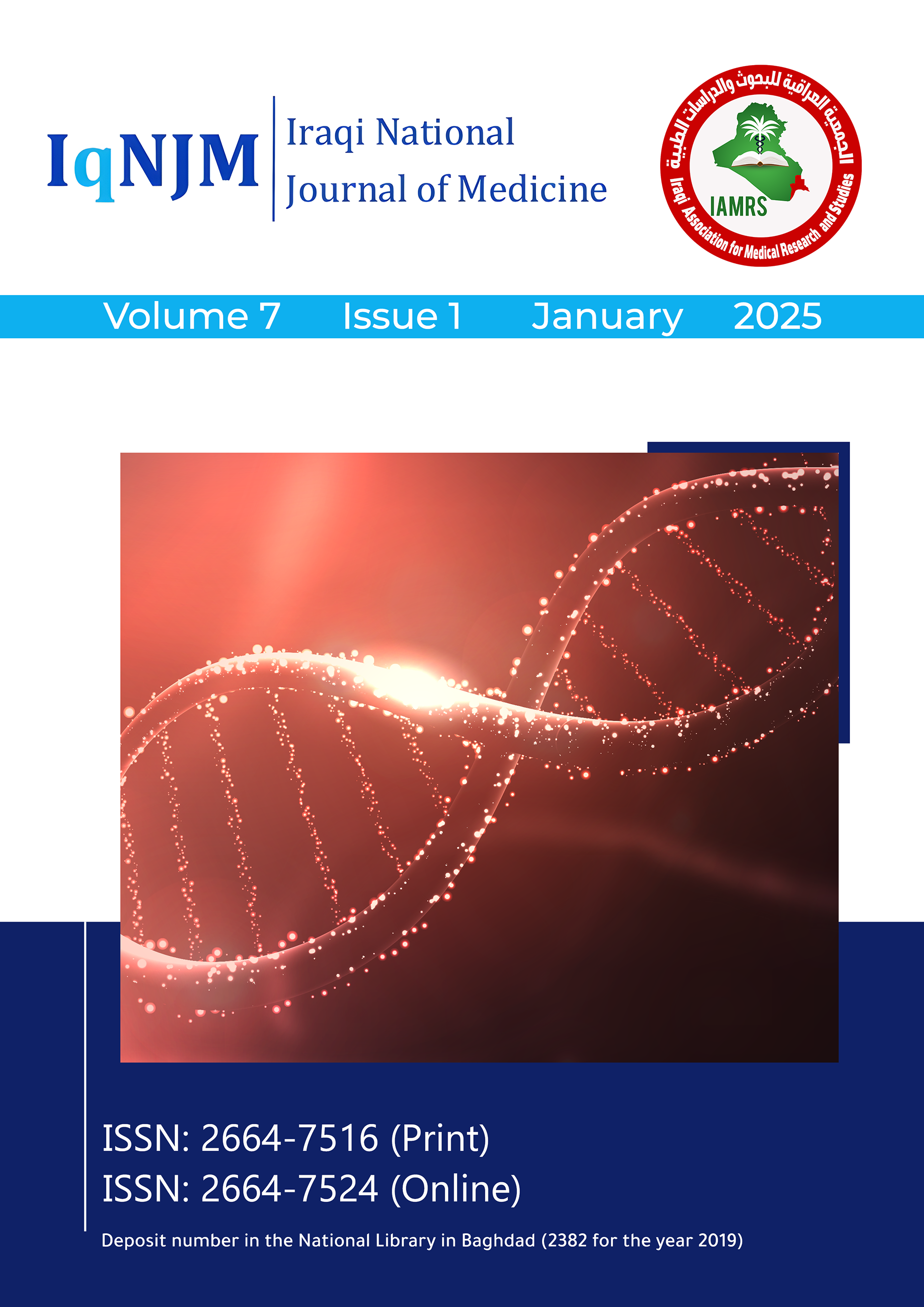The diagnostic value of tumor markers (CA242, CA19-9, CEA) in patients with adenocarcinoma of the stomach
Main Article Content
Keywords
tumor marker, CA242, CA19-9, CEA, adenocarcinoma of stomach
Abstract
Background: Gastric cancer is a significant health issue worldwide; it ranks fourth among cancers, following those of the lung, breast, and colon. Tumor markers can be utilized as screening and diagnostic tests for neoplastic diseases. Aim: This study aims to evaluate value and the efficacy of tumor markers (CA242, CA19-9, CEA) in patients with gastric carcinoma and to investigate the utility of single and combined tumor markers for the diagnosis of gastric carcinoma. Methods: The serum level of CA242, CA19-9, and CEA were measured in 40 patients with gastric carcinoma, using the ELISA technique, compared with 20 patients with benign gastric conditions and 20 healthy controls. Chi-square tests and F-test were employed for statistical analysis. Results: The mean age of patients with gastric cancer was 54.7 ± 12.8 years, with a male-to-female ratio of approximately 1.2:1. Serological data indicated that 60%, 37.5%, and 50% of these patients had positive results for CA242, CA19-9, and CEA, respectively. A statistically significant difference was observed in the mean serum level of CA19-9 between gastric cancer patients and controls. Additionally, CA242 demonstrated the best sensitivity (CA242 71%), while CA19-9 exhibited the highest specificity. The combination of tumor markers (CA19-9 and CEA), (CA242 and CEA), and (CEA and CA19-9) increased specificity to 97%. Conclusion: The novel tumor marker CA242 was the most sensitive for gastric cancer while CA19-9 was the most specific. Furthermore, a significant increase in serum CA19-9 levels was of diagnostic value. The combination of two tumor markers enhanced the specificity of the test.
References
2. Brenner H, Rothenbacher D, Arndt V. Epidemiology of stomach cancer. Cancer Epidemiol. 2009;472:467–77.
3. Crew KD, Neugut AI. Epidemiology of gastric cancer. World J Gastroenterol. 2006 Jan 21;12(3):354–62.
4. Correa P, Piazuelo MB. Natural history of Helicobacter pylori infection. Dig Liver Dis. 2008;40(7):490–6.
5. Brenner H, Rothenbacher D, Arndt V. Epidemiology of stomach cancer. Cancer Epidemiol. 2009;472:467–77.
6. National Cancer Institute [Internet]. Fact sheet. 2011. Available from: m.cancer.gov.
7. Atlallah AM, AL-Ghawalby NA, Abddel Aziz AAF. Clinical value of serum CEA, CA 19-9 CA242 and AFP in diagnosis of gastrointestinal tract cancers. Int J Cancer Res. 2006;2(1):50.
8. Röthlin MA, Joller H, Largiadèr F. CA 242 is a new tumor marker for pancreatic cancer. American Cancer Society. 2006;71:701–3.
9. Kato K, Taniguchi M, Kawakami T, Nagase A, Matsuda M, et al. Gastric cancer with a very high serum CA 19-9 level. Gastroenterol. 2011;5(1):258–61.
10. Korkmaz M, Ünal H, Selçuk H, Yilmaz U. Extraordinarily elevated serum levels of CA 19-9 and rapid decrease after successful therapy. Turk J Gastroenterol. 2010;21(4):461–3.
11. Xiaowen Liu, Hong Cai, Yanong Wang. Prognostic significance of tumor markers in T4a gastric cancer. World J Surg Oncol. 2012;10:68.
12. American Society of Clinical Oncology (ASCO) [Interent]. Understanding tumor markers. 2012. Available from: www.cancer.net.
13. Kılıçkap S, Tapan U, Yalçn S. Metastasis to bone from gastric cancer. Cumhuriyet Medical Journal. 2010;32:192–8.
14. Al-Mahrouqi H, Prakin L, Sharples K. Incidence of stomach cancer in Oman and the other Gulf Cooperation Council Countries. Oman Med J. 2011;26(4):258–62.
15. Iraq Cancer Registry Center (ICRCR), Ministry of Health. 2005.
16. National Cancer Institute. SEER cancer statistics review 1975–2009. 2005.
17. Crew KK, Neugut AI. Epidemiology of gastric cancer. World J Gastroenterol. 2006;12(3):354–62.
18. Schlansky B, Sonnenberg A. Epidemiology of noncardia gastric adenocarcinoma in the United States. Am J Gastroenterol. 2011;106:1978.
19. Crew KD, Neugut AI. Epidemiology of upper gastrointestinal malignancies. Seminars in Oncology. 2004;31(4):450–64.
20. Steevens J, Schouten LJ, Goldbohm RA, van den Brandt PA. Alcohol consumption, cigarette smoking and risk of subtypes of oesophageal and gastric cancer. Gut. 2010;59(1):39–48.
21. Kuusela P, Hagland C, Robert PJ. Comparison of a new tumor marker CA 242 with CA 19-9, CA 50 and CEA in digestive tract disease. Br J Cancer. 1991;63:636–40.
22. Ishigami S, Natsugoe S, Hokita, et al. Clinical importance of preoperative carcinoembryonic antigen and carbohydrate antigen 19-9 levels in gastric cancer. J Clin Gastroenterol. 2001;1(32):41–4.
23. Hall MA. Comparison of ten serological tumor markers for the detection of gastric cancer. Journal of the Mississippi Academy of Sciences. 2002.
24. Anbreen M, Choudhary M, Zameer A, Choudhary MS. Comparison of CEA and CA 19-9 with CA 72-4 in patient with upper gastrointestinal carcinoma in local population. Biomedica. 2010;26:6–19.
25. Carpelan-Holmstrom M, Louhimo J, Stenman UH, Alfthan H, Haglund C. CEA, CA19-9 and CA 72-4 improve the diagnostic accurracy in gastrointestinal cancers. Anticancer Res. 2002;22:2311–6.
26. Wobbes T, Thomas CMG, Segers G, Nagengast FM. Evaluation of seven tumor markers (CA 50, CA19-9, CA72-4, CA 195, CEA and tissue polypeptide antigen) in pretreatment sera of patients with gastric carcinoma. American Cancer Society. 1992;69(8):2036–41.
27. Pectasides DA, Mylonakis M, Kostopoulou D, Triantafillis J, Varthalitis, et al. CEA, CA19-9 and CA-50 in monitoring gastric carcinoma. Am J Clin Oncology. 1997;20(4):348–53.
28. Zhu YB, Ge SH, Zhang LH, Wang XH, Xing XF, et al. Clinical value of serum CEA, CA19-9, CA72-4 and CA242 in the diagnosis and prognosis of gastric cancer.
29. Nilson OC, Johanson B, Glimelius B, Norgaard-Pedersen A, Andren-Sandberg, et al. Sensitivity and specificity of CA242 in gastrointestinal cancer, a comparison with CEA, CA50 and CA19-9. Br J Cancer. 1992;65:215–21.
30. Koo BY, Kim CY, Yang DH, Hwang Y. Expression of tumor markers and its clinical impacts in resectable gastric cancer. J Korean Gastric Cancer Asso. 2004;4(4):235–41.
31. Takahashi Y, Takeuchi T, Sakamoto J, Touge T, Mai M, et al. The usefulness of CEA and/or CA19-9 in monitoring for recurrence in gastric cancer patients: a prospective clinical study. Gastric Cancer. 2003;6(3):142–5.


